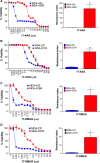Histone deacetylase activity mediates acquired resistance towards structurally diverse HSP90 inhibitors
- PMID: 28306192
- PMCID: PMC5527463
- DOI: 10.1002/1878-0261.12054
Histone deacetylase activity mediates acquired resistance towards structurally diverse HSP90 inhibitors
Abstract
Heat shock protein 90 (HSP90) regulates multiple signalling pathways critical for tumour growth. As such, HSP90 inhibitors have been shown to act as effective anticancer agents in preclinical studies but, for a number of reasons, the same effect has not been observed in the clinical trials to date. One potential reason for this may be the presence of de novo or acquired resistance within the tumours. To investigate mechanisms of resistance, we generated resistant cell lines through gradual dose escalation of the HSP90 inhibitor 17-allylamino-17-demethoxygeldanamycin (17-AAG). The resultant resistant cell lines maintained their respective levels of resistance (7-240×) in the absence of 17-AAG and were also cross-resistant with other benzoquinone ansamycin HSP90 inhibitors. Expression of members of the histone deacetylase family (HDAC 1, 5, 6) was altered in the resistant cells. To determine whether HDAC activity contributed to resistance, pan-HDAC inhibitors (TSA and LBH589) and the class II HDAC-specific inhibitor SNDX275 were found to resensitize resistant cells towards 17-AAG and 17-dimethylaminoethylamino-17-demethoxygeldanamycin. Most significantly, resistant cells were also identified as cross-resistant towards structurally distinct HSP90 inhibitors such as radicicol and the second-generation HSP90 inhibitors CCT018159, VER50589 and AUY922. HDAC inhibition also resensitized resistant cells towards these classes of HSP90 inhibitors. In conclusion, we report that prolonged 17-AAG treatment results in acquired resistance of cancer cells towards not just 17-AAG but also to a spectrum of structurally distinct HSP90 inhibitors. This acquired resistance can be inhibited using clinically relevant HDAC inhibitors. This work supports the potential benefit of using HSP90 and HDAC inhibitors in combination within the clinical setting.
Keywords: 17-AAG; HSP90; acquired resistance; cancer; histone deacetylases.
© 2017 The Authors. Published by FEBS Press and John Wiley & Sons Ltd.
Figures







Similar articles
-
Acquired resistance to HSP90 inhibitor 17-AAG and increased metastatic potential are associated with MUC1 expression in colon carcinoma cells.Anticancer Drugs. 2016 Jun;27(5):417-26. doi: 10.1097/CAD.0000000000000347. Anticancer Drugs. 2016. PMID: 26872308
-
Acquired resistance to 17-allylamino-17-demethoxygeldanamycin (17-AAG, tanespimycin) in glioblastoma cells.Cancer Res. 2009 Mar 1;69(5):1966-75. doi: 10.1158/0008-5472.CAN-08-3131. Epub 2009 Feb 24. Cancer Res. 2009. PMID: 19244114 Free PMC article.
-
Molecular and biologic characterization and drug sensitivity of pan-histone deacetylase inhibitor-resistant acute myeloid leukemia cells.Blood. 2008 Oct 1;112(7):2896-905. doi: 10.1182/blood-2007-10-116319. Epub 2008 Jul 25. Blood. 2008. PMID: 18660379
-
Hsp90 inhibitors and drug resistance in cancer: the potential benefits of combination therapies of Hsp90 inhibitors and other anti-cancer drugs.Biochem Pharmacol. 2012 Apr 15;83(8):995-1004. doi: 10.1016/j.bcp.2011.11.011. Epub 2011 Nov 22. Biochem Pharmacol. 2012. PMID: 22120678 Free PMC article. Review.
-
Drug-mediated targeted disruption of multiple protein activities through functional inhibition of the Hsp90 chaperone complex.Curr Med Chem. 2007;14(29):3122-38. doi: 10.2174/092986707782793925. Curr Med Chem. 2007. PMID: 18220746 Review.
Cited by
-
Recent Advances in Natural Product-Based Hybrids as Anti-Cancer Agents.Molecules. 2022 Oct 6;27(19):6632. doi: 10.3390/molecules27196632. Molecules. 2022. PMID: 36235168 Free PMC article. Review.
-
BRAF and MEK Inhibitors: Use and Resistance in BRAF-Mutated Cancers.Drugs. 2018 Apr;78(5):549-566. doi: 10.1007/s40265-018-0884-8. Drugs. 2018. PMID: 29488071 Free PMC article. Review.
-
Functional stratification of cancer drugs through integrated network similarity.NPJ Syst Biol Appl. 2022 Apr 19;8(1):11. doi: 10.1038/s41540-022-00219-8. NPJ Syst Biol Appl. 2022. PMID: 35440787 Free PMC article.
-
Design of Dual Inhibitors of Histone Deacetylase 6 and Heat Shock Protein 90.ACS Omega. 2020 May 11;5(20):11473-11480. doi: 10.1021/acsomega.0c00559. eCollection 2020 May 26. ACS Omega. 2020. PMID: 32478236 Free PMC article.
-
HSF1: Primary Factor in Molecular Chaperone Expression and a Major Contributor to Cancer Morbidity.Cells. 2020 Apr 22;9(4):1046. doi: 10.3390/cells9041046. Cells. 2020. PMID: 32331382 Free PMC article. Review.
References
-
- Baker EK, Johnstone RW, Zalcberg JR and El‐Osta A (2005) Epigenetic changes to the MDR1 locus in response to chemotherapeutic drugs. Oncogene 24, 8061–8075. - PubMed
-
- Brough PA, Aherne W, Barril X, Borgognoni J, Boxall K, Cansfield JE, Cheung K‐MJ, Collins I, Davies NG and Drysdale MJ (2007) 4, 5‐diarylisoxazole Hsp90 chaperone inhibitors: potential therapeutic agents for the treatment of cancer. J Med Chem 51, 196–218. - PubMed
-
- Chambers AF (2009) MDA‐MB‐435 and M14 cell lines: identical but not M14 melanoma? Cancer Res 69, 5292–5293. - PubMed
Publication types
MeSH terms
Substances
LinkOut - more resources
Full Text Sources
Other Literature Sources
Medical
Research Materials

